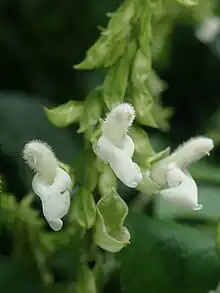| Salvia alba | |
|---|---|
 | |
| Scientific classification | |
| Kingdom: | Plantae |
| Clade: | Tracheophytes |
| Clade: | Angiosperms |
| Clade: | Eudicots |
| Clade: | Asterids |
| Order: | Lamiales |
| Family: | Lamiaceae |
| Genus: | Salvia |
| Species: | S. alba |
| Binomial name | |
| Salvia alba J. R. I. Wood | |
Salvia alba is an annual or perennial herb that is native to southern Bolivia and northern Argentina, growing in the Tucuman-Bolivian forest belt in disturbed areas of semi-shaded moist woodland. In modern times it has been seen growing at 1,000 to 2,100 metres (3,300 to 6,900 ft) elevation, though there are records of a wider range of growth.
S. alba is short-lived, upright, and many-branched, reaching approximately 1.5 metres (4.9 ft), though it is often shorter, with mature plants frequently eaten by insects. Petiolate leaves are ovate or ovate-elliptic, 4 to 14 cm (1.6 to 5.5 in) by 2 to 10 cm (0.79 to 3.94 in). The inflorescence of terminal racemes, with 4-16 verticillasters, is 4 to 16 cm (1.6 to 6.3 in) long. The 10 to 12 mm (0.39 to 0.47 in) corolla is pure white.[1]
Notes